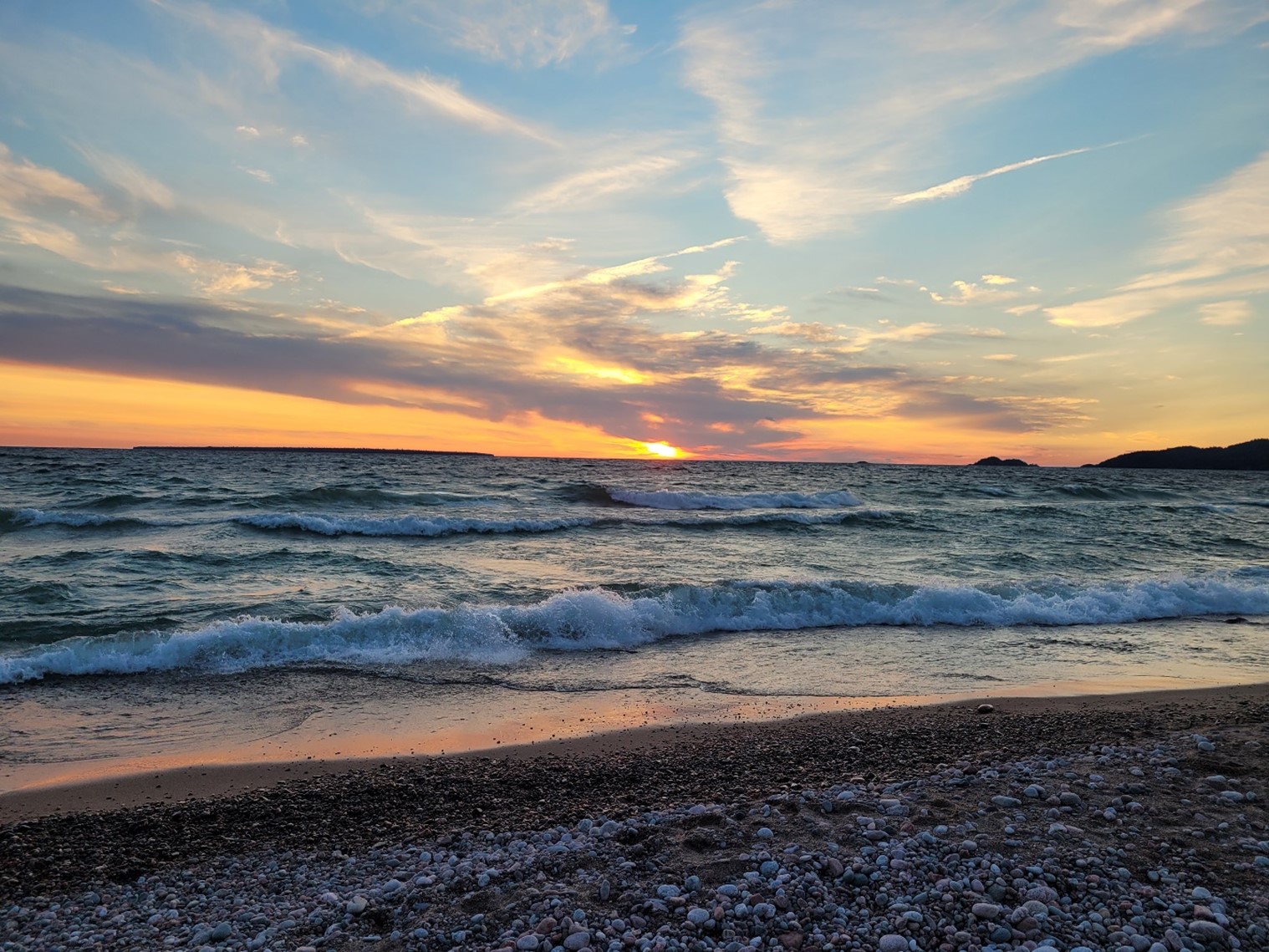
Today’s blog comes from Kaitlyn Plastino, Discovery Interpreter at Lake Superior Provincial Park.
As park staff living and working along the Lake Superior coastline, we naturally get a lot of questions about the water: “So how cold is it here anyway?” and “Is it warm enough to swim yet?”
The short answer we give visitors is: “If you aren’t used to the water, it’s probably too cold…but I’ve been swimming since May, so it’s warm enough for me!”
Here at Lake Superior Provincial Park, we have a tradition: the Daily Dip.
No matter how cold, park staff take a swim every single day from the time we arrive here in spring to the time that we leave in the fall.

That means we’re experts on how the water feels throughout the entire camping season!
Let’s explore the many questions you must have about swimming at Lake Superior Provincial Park, and why taking a dip in May is completely different from taking a dip in October.
~
Swimming in May: near-arctic temperatures
The first swim of the year is always the hardest, but perhaps the most exhilarating!
When park staff arrive in mid-May, the first thing we do is unpack and go for a swim. Well, we call it a swim, but it’s more like a quick jump-in-and-jump-out.

Agawa Bay typically loses its ice cover completely by mid-April, meaning the water has only been exposed to warming sunlight and air temperatures for about a month by the time we arrive.
After a frigid and snow-filled winter, the warm spring air is well appreciated, but very deceiving as to what it’s like to take a dip. While a sunny spring day in Agawa Bay boasts t-shirt weather, Lake Superior water screams wet-suit weather.
As we run into the water for the first time, the warmest day will average a water temperature of 5-6°C (41-43°F), enough to rip our breath away and feel like needle pricks on our skin.
Chilly, windy days can make the minimums even colder!
An overcast day can drop temperatures between 1-2°C (34-35°F). We definitely don’t stay in for long on those days, but it’s easier to get in when the lake is flat like glass.
~
Swimming in August: snorkeling, anyone?
As the summer camping season peaks, the surface temperatures of Lake Superior gradually go from freezing, to tolerable, to relaxing.
Our Daily Dips in August at Agawa Bay are by far the warmest and most comfortable since the surface water maxes out at about 20°C (68°F).

Floating at the surface, you could almost pretend you’re in the Bahamas…
…until you accidentally dip your toes a little too deep and get the cold shock of a lifetime!
This drastic change in water temperature is all thanks to a process called thermal stratification. The water’s surface is warmed by long hours of sunlight and warm air, so it maintains a low density which causes it to float as a top layer.
Deeper water receives less heat energy from the sun and stays denser so that it sits below the first layer. This layering can be tens of metres thick in the middle of Lake Superior.
Shallow inlets like Agawa Bay, however, are easily mixed by wind and have smaller and more variable thermal layers. If you’ve ever dove down to explore the beautiful rocky and sandy bottom of Agawa Bay, you’ll definitely have felt the several-degree change I’m talking about.
~
Swimming in October: winter jacket over the swimsuit
As we close our campgrounds for the season in mid-October, park staff are still hard at work preparing for next year.
By the end of October, the wind gales have picked up, and we may have even seen some snow flurries by then.
Finally, it’s time for our last Daily Dip of the year.

Autumn brings less sunlight and colder weather, chilling the surface waters of Lake Superior and beginning the process of turnover – when the summer thermal stratification is broken and mixed by strong windstorms to form one continuous layer.
By the end of October, Agawa Bay ranges from 8-11°C (46-52°F), only a couple of degrees warmer than it was on November 10, 1975 – the night the famed Great Lakes freighter the Edmund Fitzgerald was lost.
In the bone-chilling water, we reflect on what it would have been like to be on one of the many sunken ships as they went down; we marvel at the powerful changes of Lake Superior.
~
Why do the Daily Dip?
While the Daily Dip might just seem like a silly park tradition, the fact is: it’s good for you!
Swimming itself has many health benefits, but cold water has been known to heighten immunity, increase blood circulation, and give you an adrenaline rush. Unexpectedly, it also gives us a chance to socialize and make new friends.
Nothing says bonding between staff members like freezing in the lake together every day!

Finally, the Daily Dip ensures that we won’t miss a single Agawa Bay sunset. We can attest that they’re some of the best in the world.
With that, we’re off for a dip!
~
Will you join our challenge during your next visit?
Before taking a Daily Dip in Lake Superior, check out these safety tips:
- always go dipping with a buddy, especially when it’s cold
- never stay in the water for longer that a few minutes or stray too far from the shore in extreme cold temperatures
- wear a lifejacket on wavy days or if you’re not a strong swimmer, and be aware of potential undertows
- not every day is safe for a dip; do not swim during a thunderstorm
- know your limit and stay within it
- be sure to warm up after your swim with a hot chocolate!


